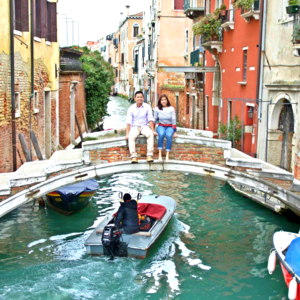Advertisement
Published: March 6th 2016

 Ponte Chiodo
Ponte Chiodo
1 of 2 bridges in Venice that do not have parapetsIf William Shakespeare had worked as a tour guide, his vivid depictions of Venice would've put Rick Steves out of business. Shakespeare's 16th century play,
The Merchant of Venice, portrayed a bustling port on the Adriatic that at the time, was the envy of the world. It has since lost the status of a premier financial capital, although stuck in time are the beautiful architecture and romantic ambiance that only this city can exude. But hurry to book your trip because the Floating City won't be floating for long, as researchers have reported the town is sinking up to 20 cm each century, meaning the frequent winter flooding will only worsen. Some even estimate Venice will be submerged in 70 years, so unless you plan on donning scuba gear to visit St.Mark's, the time to go is now.
Which is why Kristina's family and I made the 3-hour drive from Montecatini Terme to get our feet wet. While you can drive TO Venice, cars INSIDE the city are synonymous to Michael Jackson around children: prohibited. Parking is available at Piazzale Roma for Є26/day, or a tad farther out at the Venezia Terminal for Є20/day. Our family chose the former for

 Gondola
Gondola
A gondola ride costs Є80 for 30 minutesconvenience and immediately headed to the world's first Jewish ghetto in the Cannaregio district for lunch at Brek (124 Lista di Spagna), a modern and hip joint catering to the younger crowd. In a city where cheap deals are harder to find than Hillary's emails, this cafeteria-style restaurant is perfect for a quick meal before sight-seeing. We tried some local salads, pasta with fish and tomato sauce, and ended with a regional invention, tiramisu. This gave us enough energy to confront the cold and fight our way to the first stop, Ponte Chiodo. This is one of two bridges in town without parapets, allowing us to sit on the edge for a Pinterest-worthy photo as a boat floated below.
We continued east to the water where we took the traghetto, what locals use to cross the Grand Canal when one of the four main bridges aren't nearby. The traghetto is a poor man's version of the gondola--which charges Є80 for 30 minutes--so we gladly forked over Є2/person to cross the Canal to the Ricalto Fish Market. The pungent odor and flurry of pigeon poop dissuaded us from trying the otherwise fresh produce here, but if you don't mind the

 Rialto Bridge
Rialto Bridge
The marble bridge reconstructed after its previous wooden designs collapsedoccasional suspicious stain, have at it.
Afterwards, our group proceeded southeast to the Rialto Bridge (Ponte Rialto), a Venetian hallmark that was rebuilt with marble after collapsing from its wooden design. The Bridge is reminiscent of the Ponte Vecchio in Florence, flanked by souvenir shops that are oblivious to the concept of competition, as they all sell the same products. We decided to pick up some sun-dried tomatoes and squid-ink pasta as gifts for friends back home, before meandering south to the Merceria District, a high-end shopping area inevitably found in every tourist town; only difference is that these stores are surrounding by water.
A short stroll towards the lagoon and we landed at the iconic image of the city, St.Mark's Square (Piazza San Marco). This plaza imitated by the Venetian Hotel in Vegas blows any replica out of the water, because nothing can truly reproduce the awe of blue skies, beautifully adorned buildings, and pigeon flocks quite like the real thing. On one side is St.Mark's Basilica (Basilica di San Marco), the burial site of Venice's patron saint, where legends says two merchants smuggled his corpse out of Egypt in 828 A.D. in a barrel of pork

 Squid-Ink Pasta
Squid-Ink Pasta
This and tiramisu are among the famous dishes invented in Venicefat. Next to this is the Doge's Palace (Palazzo Ducale), where the chief of the Venetian Republic once lived. On the southern end of the square is the Belltower (Campanile) where Galileo introduced his telescope to the world in 1609, and just east of this is the Bridge of Sighs (Ponte dei Sospiri), which connects the Palace to the prison across the canal. The name arises from prisoners exhaling a last sigh as they looked through the bridge windows while being led from the courthouse to their cell, which conveys a gloomy sentiment for the otherwise upbeat legend that claims couples who kiss under the bridge will discover eternal love.
After admiring the gorgeous facade of this bridge, we made our way towards another famous landmark on the Grand Canal, the Ponte dell'Accademia. This wooden bridge offers the best view of the Basilica di Santa Maria della Salute and was originally intended to be replaced by a permanent structure, but locals adored the bridge so much it remained untouched. Crossing this landed us in the Dorsoduro district, a predominantly residential area packed with back-alleys for those eager to explore. We spent a little time perusing the streets while searching

 View into the Lagoon
View into the Lagoon
Our view from St.Mark's Square overlooking the lagoon and its many idling gondolasfor a dinner spot, finally settling on an eatery serving risotto, squid-ink pasta, four-cheese gnocchi, and calamari. The dishes were delectable and ended the day on a tasty note, so we left dinner satisfied. We returned to the car to make the long drive back to Tuscany for a good night's rest, because on our plate for the next day were San Gimignano and Siena.
Advertisement
Tot: 0.419s; Tpl: 0.014s; cc: 9; qc: 58; dbt: 0.1132s; 1; m:domysql w:travelblog (10.17.0.13); sld: 1;
; mem: 1.2mb








